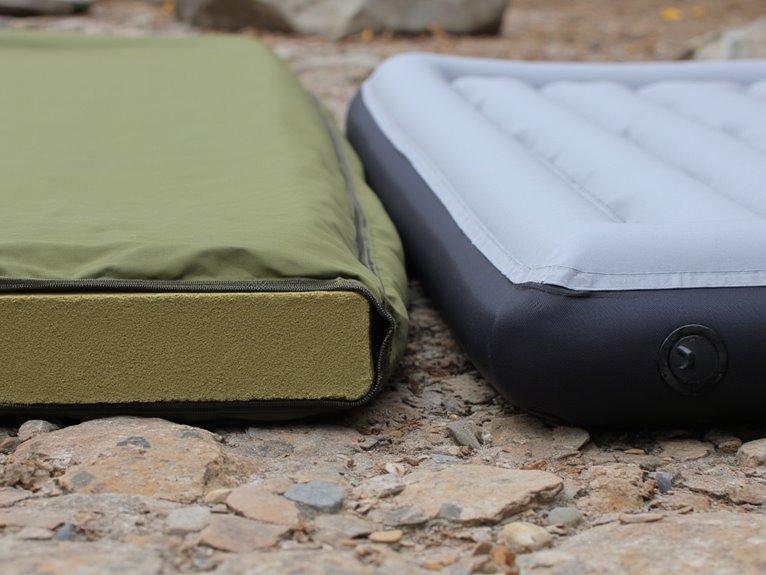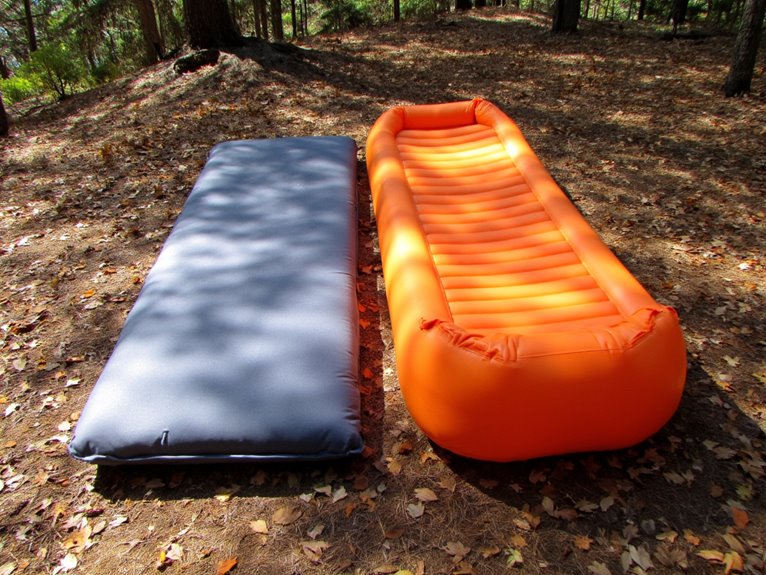Difference Between Sleeping Pad and Air Mattress
You’ll find sleeping pads weigh 1-5 pounds with R-values up to 8, making them ideal for backpacking where thermal efficiency matters most. Air mattresses weigh 5-20 pounds but offer superior comfort with 4-9+ inch thickness compared to sleeping pads’ 1-4 inches. Sleeping pads use 40D-50D nylon with TPU coatings for durability, while air mattresses rely on PVC materials prioritizing comfort over weight. Your choice depends on whether you’re car camping or backpacking, as each category serves distinct outdoor needs with specific performance advantages.
We are supported by our audience. When you purchase through links on our site, we may earn an affiliate commission, at no extra cost for you. Learn more. Last update on 5th December 2025 / Images from Amazon Product Advertising API.
Notable Insights
- Sleeping pads weigh 1-5 pounds and pack smaller, while air mattresses weigh 5-20 pounds and take up significantly more space.
- Air mattresses provide superior comfort with 4-9+ inch thickness and adjustable firmness compared to sleeping pads’ 1-4 inch thickness.
- Sleeping pads offer better insulation with R-values up to 8, while air mattresses prioritize comfort over thermal performance.
- Sleeping pads deploy instantly or inflate in 10-60 seconds, while air mattresses require 3-10 minutes and often need pumps.
- Sleeping pads use durable ripstop nylon with TPU coatings, while air mattresses use lighter PVC materials more prone to punctures.
Comfort and Sleep Quality Comparison
When it comes to pure comfort, air mattresses consistently outperform sleeping pads in cushioning and sleep quality.
You’ll experience superior body support due to their adjustable firmness and bed-like thickness. Air mattresses cradle your body at higher volumes, preventing pressure points common with thinner alternatives.
The elevated sleep surface reduces ground contact, maintaining consistent support on uneven terrain. You’ll find less air loss during nighttime hours, avoiding sagging issues that compromise rest quality.
Air mattresses provide ample space for movement, benefiting restless sleepers considerably.
Sleeping pads offer reasonable comfort but typically require foam mat combinations for enhanced support. Foam sleeping mats may not provide adequate support for light sleepers or those who prefer side sleeping positions.
User preferences vary, though air mattresses’ velvety covers and plush cushioning create tactile advantages. However, you’ll face longer setup times and potential durability concerns that sleeping pads avoid.
Air mattresses are more prone to leaks or punctures compared to the durability advantages of sleeping pads. For optimal comfort, sleeping pads should feature memory foam variants that provide superior support compared to conventional alternatives.
Insulation and Thermal Performance

Thermal performance creates the most significant difference between sleeping pads and air mattresses in cold-weather camping.
You’ll find sleeping pads typically offer R-values between 1-8, while air mattresses generally range from 3-7. Inflatable sleeping pads achieve superior heat retention through specialized designs like interconnected air cells that minimize internal air movement. This stability prevents warmth dissipation that occurs when air circulates freely.
Air mattresses prioritize comfort over insulation effectiveness, using larger air chambers that allow more air movement.
Moving air inside these chambers reduces thermal performance by carrying heat away from your body. Closed-cell foam pads provide consistent insulation but lower R-values than quality inflatable options. Foam pads also offer quick setup without requiring inflation time or equipment. Unlike inflatable options, closed-cell foam pads eliminate puncture risk completely due to their solid construction.
For temperatures below 40°F, you’ll need sleeping pads with R-values above 4 for adequate ground insulation and thermal protection. Women typically require sleeping bags rated 10-15 degrees warmer than standard to maintain proper thermal regulation during cold-weather camping.
Weight and Portability Factors
When you’re planning your next camping adventure, weight and packed size become critical factors that can make or break your experience on the trail.
Air mattresses typically weigh between 5–20 pounds and pack down to a bulky size even when deflated, while sleeping pads range from just 1–5 pounds with ultralight models weighing as little as 13–20 ounces.
Your choice between these two options will directly impact your mobility, energy levels, and overall pack management during multi-day excursions. For ultralight camping enthusiasts, weight becomes a significant factor when every ounce counts toward achieving optimal performance on extended hiking trips.
Many ultralight sleeping pads feature built-in foot pumps that eliminate the need for separate pumping equipment, further reducing the total weight of your gear setup.
Ultralight pads are ideal for backpacking but often come at a higher price.
Weight Comparison Analysis
Most camping sleep systems fall into two distinct weight categories that directly impact your gear selection strategy.
Air mattresses typically weigh 5-20 pounds, while sleeping pads range from 1-5 pounds. This significant difference creates clear weight advantages for backpackers prioritizing mobility.
- Sleeping pads offer superior portability with models like the Therm-a-Rest NeoAir XTherm NXT weighing just 20 ounces.
- Air mattresses provide enhanced comfort but sacrifice pack weight efficiency for extended hiking trips.
- Weight distribution differs substantially—sleeping pads compress into smaller, more manageable burdens.
- Hiking preferences strongly favor lightweight options, making sleeping pads the preferred choice for trail adventures.
You’ll face a fundamental tradeoff between comfort and weight.
Sleeping pads excel in weight-sensitive scenarios, while air mattresses suit car camping where transport limitations don’t constrain your gear choices. Closed-cell foam pads represent the lightest option at approximately 10-14 ounces with complete puncture resistance. Air mattresses accommodate dual chambers for customized firmness levels on each side.
Pack Size Considerations
Beyond weight considerations, pack dimensions create equally important constraints for your gear selection. Ultralight sleeping pads compress to remarkably small sizes—some models pack down to just 9 x 4 inches. This storage efficiency allows you to maximize backpack space for other essential gear.
Air mattresses present significant packing challenges. Full-size models consume considerable space even when deflated, making them impractical for backpacking. You’ll need dedicated storage areas rather than compact pack integration.
Sleeping pads offer superior storage efficiency through innovative design features. Mummy-shaped pads reduce volume while maintaining comfort. Short 48-inch models provide additional space savings, letting you use folded clothing for leg insulation. Traditional rectangular pads provide more room to move but sacrifice some packability for enhanced sleeping area. Air Sprung Cell pads use high tensile strength nylon materials that enhance packability without sacrificing durability.
Most standard pads measure 20 inches wide, though 25-inch options exist for those preferring extra space without major pack dimension penalties.
Durability and Material Construction

When you’re choosing between sleeping pads and air mattresses, puncture resistance becomes a critical factor that directly impacts your gear’s lifespan.
Sleeping pads constructed with closed-cell foam or hybrid materials resist tears and punctures greatly better than air mattresses, which rely on thin synthetic membranes that can fail when exposed to sharp objects or rough terrain.
The material quality differences are substantial—sleeping pads use denser, more resilient materials while air mattresses depend on lighter PVC or nylon that prioritizes weight savings over durability.
High-quality sleeping pads feature 40D-50D nylon construction with TPU coating that significantly enhances their resistance to outdoor wear and tear compared to standard air mattresses.
Puncture Resistance Comparison
Although both sleeping pads and air mattresses face similar outdoor hazards, their puncture resistance varies considerably based on material construction and thickness. Puncture resistance testing methods reveal significant differences between these products through specialized machinery like Instron Tensile Strength testers that simulate real-life scenarios.
Several durability factors determine puncture resistance performance:
- Material thickness – Lower gauge numbers indicate thicker materials with superior puncture resistance
- Construction type – Fiber-Tech internal constructions enhance overall durability compared to basic designs
- Material composition – TPU materials typically offer better durability and memory than PVC alternatives
- Surface treatment – Flocked surfaces can be more vulnerable to puncture damage during testing
Air mattresses generally feature thicker materials but sacrifice portability.
Sleeping pads prioritize weight reduction while maintaining adequate puncture resistance for backpacking conditions.
Material Quality Differences
Material construction differences between sleeping pads and air mattresses extend far beyond simple thickness measurements, encompassing distinct engineering approaches that directly impact field performance.
Sleeping pads utilize advanced material sourcing strategies, incorporating ripstop nylon with 20D to 75D fabric weights for optimal puncture resistance. Air mattresses typically employ PVC or vinyl materials ranging from 0.35mm to 0.6mm thickness.
Manufacturing processes differ considerably between products. Sleeping pads integrate closed-cell foam layers or down insulation during assembly, creating multi-laminate structures. Air mattresses rely on heat-welded seams and single-chamber designs.
You’ll find sleeping pads feature TPU coatings for enhanced durability, while air mattresses use flocked surfaces for comfort. These material choices directly affect weight distribution, with sleeping pads averaging 1-2 pounds versus air mattresses at 3-8 pounds.
Setup Process and Ease of Use
Setup efficiency often determines whether you’ll enjoy your camping experience or struggle with frustration before you even sleep. Air mattresses demand inflation time through manual pumping, built-in electric pumps, or external devices, typically requiring 3-10 minutes for full setup.
Setup efficiency can make or break your camping trip before you even lay down to rest.
Setup convenience varies dramatically between these sleep systems. Sleeping pads offer superior inflation methods, with closed-cell foam requiring zero preparation—simply unroll and use immediately.
Key differences in setup convenience include:
- Sleeping pads: Instant deployment with foam types, 30-second valve opening for self-inflating models
- Air mattresses: 5-10 minutes inflation time, require power sources or manual effort
- Weather dependency: Air mattresses struggle in cold conditions, pads remain unaffected
- Required accessories: Sleeping pads need nothing extra, air mattresses often require pumps or adapters
Sleeping pads consistently provide faster, simpler deployment across all camping scenarios. Modern sleeping pads equipped with built-in foot pumps can inflate in as little as 10-60 seconds, eliminating the need for external equipment entirely.
Price Range and Size Options

Budget considerations play a crucial role in choosing between sleeping pads and air mattresses, with both categories offering distinct value propositions across different price points. A thorough price comparison reveals sleeping pads range from $20 for basic foam models to $200+ for premium insulated versions.
Air mattresses start at $30 for cheap inflatables and reach $250+ for high-end car camping models.
Size characteristics differ appreciably between categories. Sleeping pads offer standard widths of 20–25 inches, while air mattresses provide single options at 30–40 inches wide.
You’ll find sleeping pad thickness ranges from 1–4 inches compared to air mattresses at 4–9+ inches. Budget-friendly sleeping pads around $100 deliver robust comfort and insulation, while mid-range air mattresses ($70–$150) often sacrifice insulation for comfort.
Best Use Cases for Each Option

Beyond financial factors, selecting the right sleep system hinges on your specific outdoor activities and camping conditions. Different sleeping types require distinct features and capabilities.
For backpacking and multi-day trekking, you’ll need lightweight sleeping pads with high R-values. These compact designs pack efficiently while providing essential ground insulation during variable weather conditions.
Car camping and short-term stays benefit from thicker air mattresses that prioritize comfort over portability. Their superior cushioning and larger surface area enhance leisure camping experiences.
- Cold weather camping: Sleeping pads offer better thermal resistance and compatibility with sleeping bags
- Versatile outdoor activities: Pads double as seat cushions and exercise mats
- Quick setup: Sleeping pads require minimal inflation compared to air mattresses
- Rough terrain: Closed-cell foam pads withstand harsh conditions better than air mattresses
Frequently Asked Questions
Can You Use a Sleeping Pad and Air Mattress Together?
You can definitely use a sleeping pad and air mattress together.
This combination maximizes sleeping pad benefits like superior insulation and stability while retaining air mattress advantages such as plush comfort.
Position the sleeping pad on top of the air mattress for ideal warmth retention.
This setup works best for car camping where weight isn’t critical, providing enhanced comfort for cold-weather conditions.
How Do You Repair Punctures in Sleeping Pads Versus Air Mattresses?
You’ll use different puncture repair methods for each.
Sleeping pads require peel-and-stick patches or Tenacious Tape after cleaning with alcohol. You can test immediately after application.
Air mattresses need adhesive-based plastic patches with longer cure times.
The sealing methods differ notably: sleeping pads use instant-bond patches while air mattresses require adhesive curing for several hours before testing.
Are There Specific Brands Recommended for Sleeping Pads or Air Mattresses?
You’ll find distinct brand leaders for each category.
The best sleeping pads include NEMO Tensor All-Season and Therm-a-Rest NeoAir XLite NXT, which offer superior R-values and ultralight designs.
Popular air mattresses feature Intex’s quick-inflate models and Coleman’s durable options for car camping.
Sleeping pad brands typically provide lifetime warranties, while air mattress manufacturers offer 1-2 year coverage standards.
What’s the Typical Lifespan of Sleeping Pads Compared to Air Mattresses?
You’ll find sleeping pads have superior life expectancy compared to air mattresses.
High-quality sleeping pads last up to 26 seasons with proper care, while air mattresses typically endure fewer seasons due to increased puncture risk.
This durability comparison stems from construction differences – sleeping pads use reinforced materials and seams, whereas air mattresses rely on thicker but more puncture-prone materials like PVC that degrade faster.
Do Sleeping Pads Work Better for Side Sleepers or Back Sleepers?
You’ll find sleeping pad comfort works better for side sleepers than back sleepers.
Side sleepers need thicker pads (2.5-4 inches) with targeted cushioning to support hips and shoulders, reducing pressure points.
Back sleepers require less padding since they distribute weight more evenly.
While air mattress support can work for back sleepers, it lacks the pressure relief side sleepers need for comfortable sleep.
On a final note
You’ll find sleeping pads excel for backpacking where weight matters most, typically weighing 1-2 pounds with R-values up to 6.5 for superior insulation. Air mattresses work better for car camping, offering 6-10 inches of thickness but weighing 3-8 pounds. Consider your priorities: weight and thermal efficiency favor sleeping pads, while comfort and ease of setup favor air mattresses. Match your choice to your specific outdoor activity requirements.




